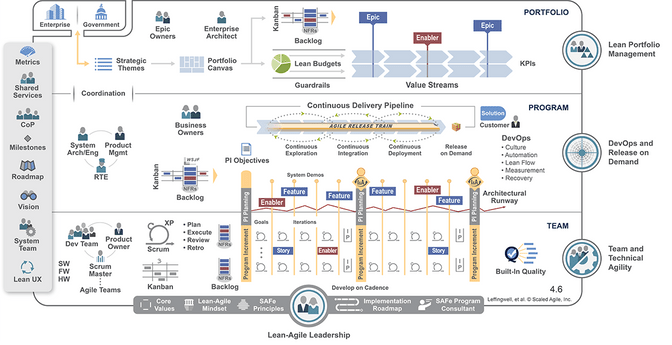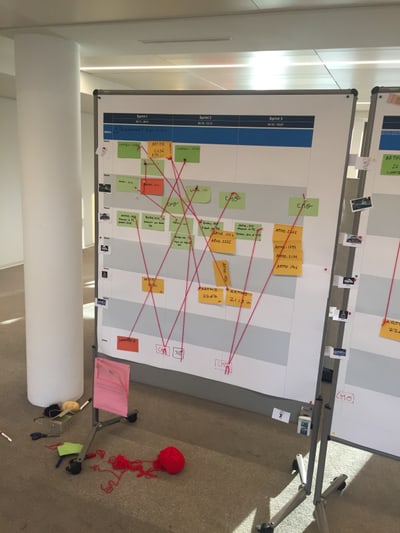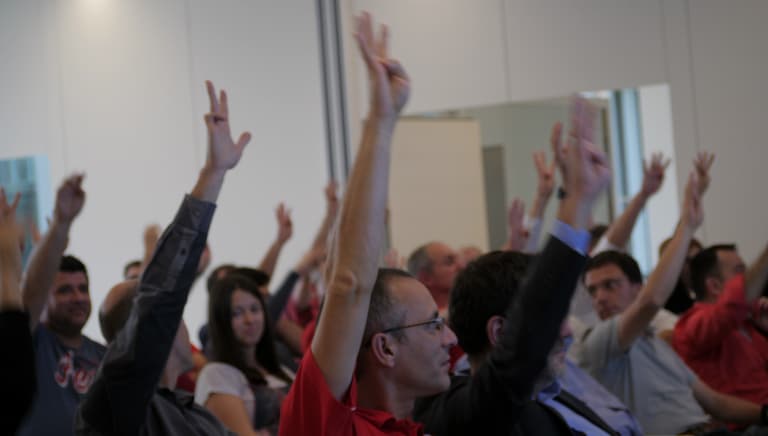La Mobilière has been using the SAFe framework to organise its IT delivery for the last 2 years. I had the chance to attend the "PI Planning" in Nyon last week, were 7 teams gathered to plan the next 3 months of work. Here are 5 positive takeaways from this intense day, and about SAFe in general.
It’s all about teams
It might not be easily graspable from the huge SAFe diagram but in the end the whole process aims at giving development teams the best material to do their work. Mobiliar IT is organised around 40 Scrum teams, all working with the same cadence: 5x 2 weeks Sprints and 1x innovation Sprint per quarter, together forming a Product Increment (or PI).
The day began with some motivational and inspirational speeches around teamwork, including the famous Al Pacino speech in the movie “Any given Sunday”. This focus on teams might ring a bell to the readers of my previous blogpost about The Loop Approach.
Self-organised teams are the best vehicles to generate value.

Roles around a business process rather than hierarchy
People may be scared by the apparent complexity of SAFe (this fear resonates with me as well) but one thing that I really like is that it is organised with specific roles around value delivery, rather than a hierarchical pyramid of authority. Of course the standard hierarchy still exists at Mobiliar, but SAFe makes sure that for most people, their day is organised by the value they provide rather than who they report to. If you are using Scrum you certainly know what I mean, as there is no hierarchical level between the Product Owner and a Developer, just different responsibilities. At Liip we use Holacracy and the role structure has helped greatly to clarify who is accountable for what, and make sure decision can be taken where appropriate without the need for escalation.
Iterations at all levels
In my opinion, one of the biggest advantages of using Agile methodologies is the learning mindset they foster. Every practice is challenged and this continuous challenging generates continuous improvements. I have spent only one day at Mobiliar and I witnessed this mindset at various levels, from a very broad scale to a very detailed one. SAFe’s PI introduces a 3-month cycle which allows for reflection and improvement at a global scale. As an example of a global scale, a question like “how could we improve our estimate of the delivered work for next PI?” could emerge. While, at a detailed scale, the practice of team coordination during the day was challenged and improved on the spot last Monday. Continuous improvement for the win!
Collaboration first
I was very pleasantly surprised by the degree of collaboration that happened during the day. When you work with multiple parallel teams quite some coordination is needed. Scrum Masters and Product Owners were buzzing from one team to the other to make sure risks and dependencies were identified and communicated. The team that had too much on its plate found a generous partner to take over some extra work.

This collaboration was not restricted to teams. The last event of the day was the “Management review” where the biggest risks identified for this PI are discussed and mitigated. I just loved how this part was handled: in a very pragmatic, transparent way. Both the “management” (read hierarchical stakeholders outside of the SAFe process), Product Managers and representatives of the teams were discussing one problem at a time, focusing on finding actionable solutions to relieve the teams. Kudos!
Business value driven
At Liip we fight strongly to focus on maximising value, using techniques like Lean Startup Canvas or Minimum Viable Product (MVP). SAFe is similar to Scrum in this regard, the transparency regarding capacity forces a strong product portfolio management prioritisation.
This portfolio management of course happened before the PI Planning, and probably generated quite some discussions :). During PI Planning the products impacted were presented, based on priority and their position in the roadmap to give everyone a good understanding of the business needs. A more detailed case about an important product was presented focusing on the goals of the product, whom it targeted and what was its USP. I can’t stress this enough: focusing on the why makes all the difference, regarding both motivation and understanding.
SAFe enough to try?
Of course, SAFe also has some blind spots (it’s no surprise if Mobiliar also maintains some “speed boat” teams on the side), and probably mostly make sense for huge IT organisations. But I was delighted to see that the Agile values can survive and flourish in such a structured, large-scale environment.
Interested in discussing how you could evolve your organisation towards more agility? Don’t hesitate to contact us.

